Table of Contents
Are you curious about Microservice architecture?
In the ever-evolving landscape of mobile app development, staying ahead requires embracing innovative approaches that enhance scalability, flexibility, and overall performance.
One such groundbreaking methodology that has taken the tech world by storm is the Microservice Architecture.
This approach, which revolves around breaking down a complex application into smaller, interconnected services, offers a plethora of advantages for mobile app development.
In this comprehensive guide, we’ll delve deep into the world of Microservice Architecture, exploring its benefits, implementation strategies, best practices, real-world examples, and when to choose this approach for your project.
Understanding Microservice Architecture

One of the first question people ask about Microservice architecture is, what is it?
Microservice Architecture is an architectural style where a complex application is divided into smaller, loosely coupled services.
Moreover, Each service operates independently and communicates with others via APIs, enabling them to be developed, deployed, and scaled independently.
It is better understandable via real-world example, so let’s look at them below:
Real-World Examples of Microservice-Based Mobile Apps
- Uber– Uber’s microservice architecture enables seamless coordination of ride booking, GPS tracking, payments, and more, ensuring a smooth user experience.

- Airbnb– Airbnb’s approach allows independent management of features like property listings, bookings, payments, and messaging, contributing to their rapid growth.

- Netflix– Netflix’s microservices handle various functions, including user profiles, content recommendation, and streaming, providing uninterrupted entertainment.

- Spotify– Spotify’s microservices power music discovery, user playlists, and social sharing, contributing to its widespread popularity.

- Amazon– Amazon utilizes microservices to manage its vast e-commerce ecosystem, ensuring smooth shopping experiences for users.

- Twitter(now X) – Twitter’s microservices enable real-time feed updates, user interactions, and trending topic algorithms, supporting its massive user base.

Benefits of Microservice Architecture for Mobile Apps
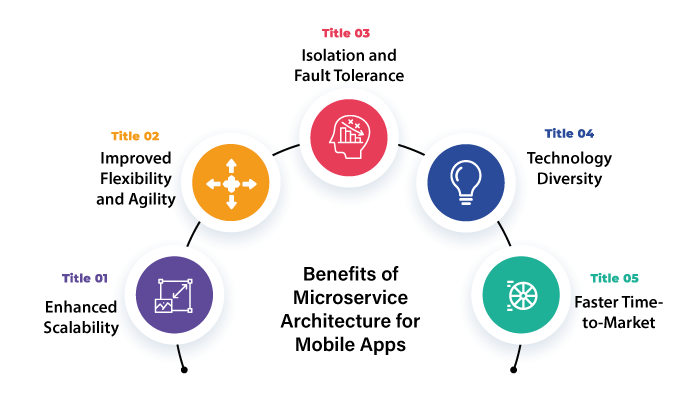
Before you find an app developer, let’s look at some good reasons to opt for microservice architecture.
These are, as mentioned below:
· Enhanced Scalability
Microservices allow you to scale specific services based on demand, optimizing resource utilization and ensuring seamless performance even during traffic spikes.
· Improved Flexibility and Agility
Microservices enable rapid updates and feature releases, enabling you to respond swiftly to market trends and user feedback without overhauling the entire app.
· Isolation and Fault Tolerance
Isolated services minimize the impact of failures. If one service fails, others continue to function, reducing downtime and enhancing overall app reliability.
· Technology Diversity
Different services can be developed using different technologies, allowing you to leverage the best tool for each task and prevent technology limitations from affecting the entire app.
· Faster Time-to-Market
Microservices streamline development cycles, allowing different teams to work on different services simultaneously, resulting in quicker updates and a competitive edge.
Key Components of Microservice Architecture
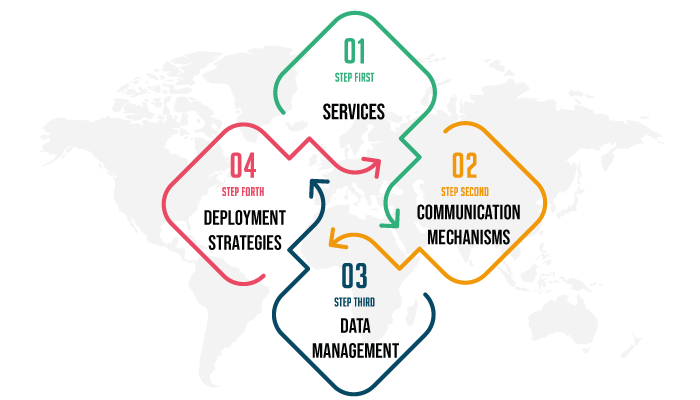
Now in a bit to understand the working of Microservice architecture let’s look at the different components of the same.
These are, as mentioned below:
Services
Services are the building blocks of a microservice architecture. They are independent, self-contained entities responsible for specific functions, facilitating easier maintenance and updates.
Communication Mechanisms
Microservices communicate via APIs, often utilizing lightweight protocols like REST or messaging systems like RabbitMQ, ensuring seamless interaction between services.
Data Management
Each service manages its own data, either using a separate database or shared data stores. This minimizes data coupling and enables better scalability.
Deployment Strategies
Containerization tools like Docker and orchestration platforms like Kubernetes simplify deployment, scaling, and management of microservices.
Implementing Microservice Architecture in Mobile App Development
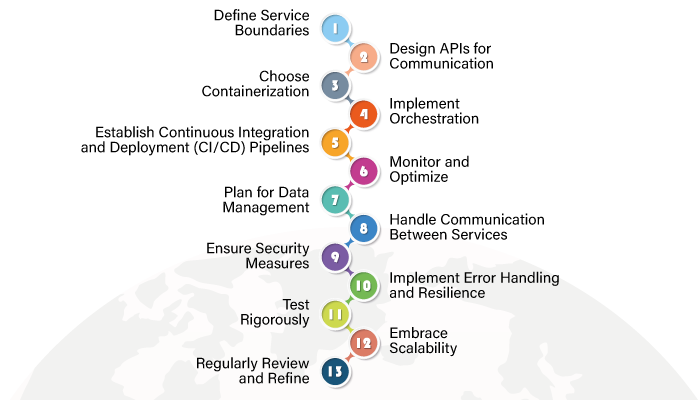
When it comes to creating modern and scalable mobile apps, embracing Microservice Architecture can be a game-changer.
This innovative approach breaks down complex applications into smaller, independent services that work seamlessly together.
In this section of the blog, you’ll discover the step-by-step process of implementing Microservice Architecture in mobile app development, ensuring a streamlined and successful project.
‘
Step 1: Define Service Boundaries
Start by analyzing your app’s functionalities and defining clear service boundaries. Identify distinct features that can be encapsulated within individual services.
Moreover, this ensures that each service has a well-defined responsibility, preventing overlap and complexity.
Step 2: Design APIs for Communication
Craft well-defined APIs for your services, outlining how they will communicate with each other.
Furthermore, here you should prioritize simplicity and clarity in API design to foster effective interactions between services.
This step is crucial for maintaining consistency and avoiding communication bottlenecks.
Step 3: Choose Containerization
Embrace containerization technology, such as Docker, to package your services and their dependencies.
This ensures that each service runs consistently across different environments, from development to production.
And containerization simplifies deployment and guarantees the reliability of your app.
Step 4: Implement Orchestration
Consider using an orchestration platform like Kubernetes to manage the deployment, scaling, and load balancing of your microservices.
You see, what orchestration does is, it streamlines the management process, allowing you to scale services up or down based on demand effortlessly.
Step 5: Establish Continuous Integration and Deployment (CI/CD) Pipelines
Automate the integration and deployment of your microservices through CI/CD pipelines.
This practice ensures that changes are thoroughly tested before being released, reducing the risk of bugs or disruptions in the production environment.
Step 6: Monitor and Optimize
Implement robust monitoring tools to keep a close eye on the performance of your microservices architecture.
Monitor metrics like response times, resource utilization, and error rates. Regularly analyze this data to identify areas for optimization.
Step 7: Plan for Data Management
Decide on a data management strategy that aligns with your app’s requirements.
You can choose to have separate databases for each service or shared data stores for certain data elements. This step ensures data consistency and prevents coupling between services.
Step 8: Handle Communication Between Services
Incorporate efficient communication mechanisms between services.
Utilize RESTful APIs for synchronous communication or consider asynchronous messaging using technologies like RabbitMQ or Kafka for more complex interactions.
Step 9: Ensure Security Measures
Prioritize security by implementing authentication and authorization mechanisms for each service. And encrypt data in transit and at rest to safeguard sensitive information.
Security measures should be a central aspect of your microservice architecture.
Step 10: Implement Error Handling and Resilience
Build error-handling mechanisms into each service to manage failures gracefully.
Then implement circuit breakers to prevent cascading failures and retries to manage transient errors.
These practices enhance the overall resilience of your app.
Step 11: Test Rigorously
It’s time to test mobile app. So, thoroughly test each microservice individually and as part of the larger ecosystem.
Perform unit tests, integration tests, and end-to-end tests to ensure that your services work seamlessly together and meet user expectations.
Step 12: Embrace Scalability
Design your architecture to accommodate dynamic scaling.
As user demand fluctuates, your microservices should be able to scale up or down seamlessly, ensuring optimal performance even during traffic spikes.
Step 13: Regularly Review and Refine
Microservice architecture is an evolving approach.
Regularly review and refine your architecture based on user feedback, changing business requirements, and technological advancements.
This agility ensures your app remains relevant and competitive.
Best Practices for Successful Microservice-Based Mobile Apps
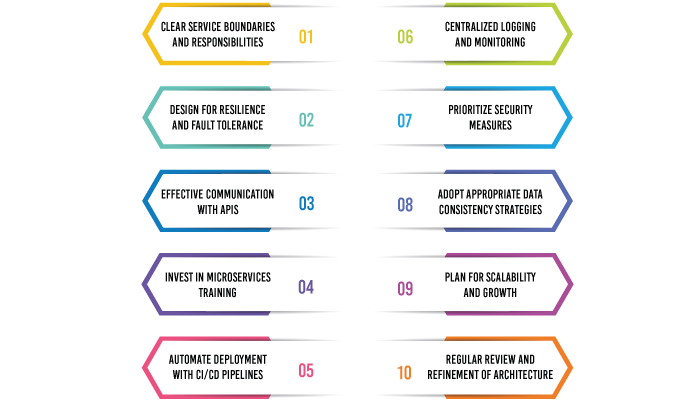
Building microservice-based mobile apps requires meticulous planning and execution. Here are the ten essential best practices to ensure your project’s success
· Clear Service Boundaries and Responsibilities
Define precise boundaries for each service based on business logic. Ensure that services have single responsibilities to prevent overlap and complexity.
· Design for Resilience and Fault Tolerance
Incorporate mechanisms for handling failures within each service. Implement circuit breakers, retries, and fallbacks to maintain app reliability.
· Effective Communication with APIs
Develop well-defined APIs with explicit contracts to facilitate seamless communication between services. Prioritize versioning and comprehensive documentation.
· Invest in Microservices Training
Equip your development teams with training on microservices concepts, architecture, and best practices. This ensures a shared understanding across the organization.
· Automate Deployment with CI/CD Pipelines
Implement automated continuous integration and continuous deployment (CI/CD) pipelines. This streamlines testing, integration, and deployment processes.
· Centralized Logging and Monitoring
Set up a centralized logging and monitoring system to track performance, troubleshoot issues, and optimize app performance across services.
· Prioritize Security Measures
Implement robust security practices, including authentication, authorization, and data encryption, to safeguard both data and services.
· Adopt Appropriate Data Consistency Strategies
Select the appropriate data consistency strategy for your app’s needs, whether it’s eventual consistency, distributed transactions, or event sourcing.
· Plan for Scalability and Growth
Design your architecture with scalability in mind. Plan for dynamic scaling based on demand to accommodate growing user bases.
· Regular Review and Refinement of Architecture
Continuously review and refine your microservices architecture to align with evolving business requirements, technology trends, and user needs.
| Microservices vs Traditional Development | ||
| Aspect | Microservice Architecture | Traditional Development |
| Structure | Decentralized, independent services | Monolithic, single-codebase architecture |
| Scalability | Granular scalability based on demand | Limited by the entire app’s scaling capabilities |
| Development Speed | Faster updates due to independent service development | Slower updates as the entire app requires modification |
| Fault Isolation | Failures contained to specific services | Failures can affect the entire app |
| Technology Diversity | Different technologies per service | Single technology stack |
When to Opt for Microservice Architecture in App Development
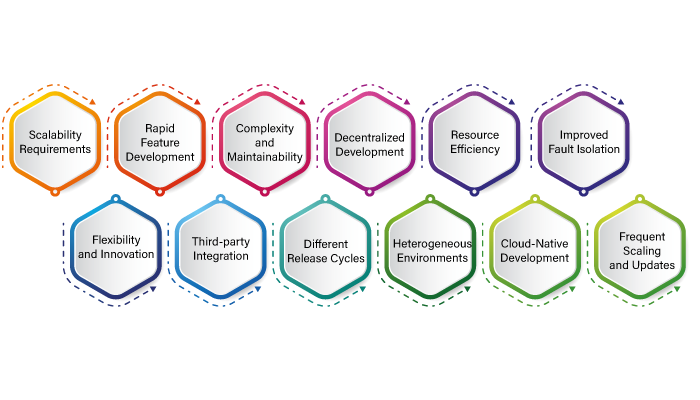
Microservice Architecture offers a paradigm shift in how applications are designed and developed.
However, it’s essential to know when to choose this approach for your app. Here are key scenarios when opting for Microservice Architecture is a strategic decision.
Scalability Requirements
When your application’s different components require varying levels of scalability. Microservices allow you to scale each service independently, ensuring efficient resource utilization.
Rapid Feature Development
If your app needs frequent updates and new features to stay competitive in a dynamic market. Microservices enable individual services to be developed, tested, and deployed quickly.
Complexity and Maintainability
For complex apps with diverse features that demand distinct technologies or programming languages. Microservices promote modular development and easier maintenance.
Decentralized Development
When you have multiple development teams or departments working on different parts of the application. Microservices align with distributed teams and facilitate parallel development.
Resource Efficiency
If you want to optimize resource usage by scaling only the necessary components during peak usage, instead of the entire application.
Improved Fault Isolation
For applications where isolating failures is critical. Microservices limit the impact of failures to specific services, minimizing downtime and improving overall reliability.
Flexibility and Innovation
When you want the flexibility to experiment and innovate with new technologies without affecting the entire application.
Third-party Integration
If your app heavily relies on third-party services or APIs. Microservices can be developed to interact with external services independently.
Different Release Cycles
When different parts of your application require separate release cycles. Microservices enable you to update specific services without affecting the entire app.
Heterogeneous Environments
For applications that need to run on different platforms or devices. Microservices can be tailored to work optimally on diverse environments.
Cloud-Native Development
When building apps for cloud environments, Microservice Architecture aligns with cloud-native principles, making deployment and management more efficient.
Frequent Scaling and Updates
If your app experiences fluctuating usage patterns, Microservice Architecture allows you to scale and update specific services in response to demand.
Conclusion
Microservice Architecture has revolutionized mobile app development, empowering developers to build agile, scalable, and resilient apps that cater to today’s fast-paced market demands. By understanding its principles, benefits, implementation strategies, best practices, and real-world examples, you’re poised to embark on a transformative journey that maximizes your app’s potential and provides users with exceptional experiences. Embrace the power of microservices and unlock new horizons in mobile app development.
FAQ
Microservice Architecture is an approach where complex applications are divided into smaller, independent services that communicate via APIs.
Microservices enable you to scale specific services based on demand, optimizing resource utilization and ensuring smooth performance.
Containerization, facilitated by tools like Docker, ensures consistent deployment across various environments, enhancing app stability.
Microservices can optimize communication by using efficient communication protocols and reducing dependencies on remote calls.
Opt for microservice architecture when your app demands granular scalability, rapid feature updates, or involves cross-functional teams.
Successful microservice development relies on clear service boundaries, effective communication, automation, and continuous monitoring.





No Comments
Comments are closed.